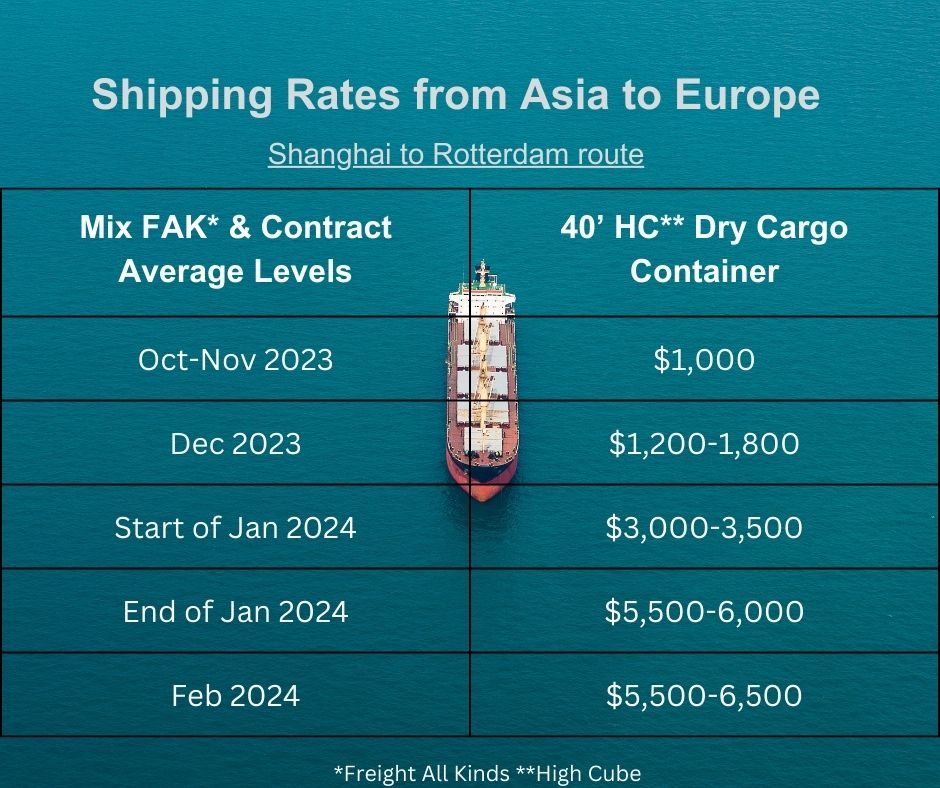
Red Sea Crisis: How Rerouting is Impacting Shipping Costs
- The Suez Canal has become a less preferred option for transporting goods, leading to higher shipping rates, prolonged transit times, and delays.
- These effects are anticipated to endure in the coming months.
- It is recommended companies secure container bookings in advance or explore alternative transportation modes.
March 11, 2024 | Supply Chain 3 minutes read
The Red Sea crisis triggered by the attack on container ships by Houthi rebels in Yemen continues to impact global shipping. The disruption has caused delays, increased costs, and disrupted supply chains, affecting major shipping canals and global trade routes.
Heightened Sea Freight Risk Through the Suez Canal
The route through the Suez Canal presents distinct challenges, with the conflict in Gaza prompting the Houthi rebels in Yemen to launch attacks using rockets and drones on ships travelling to and from the canal.
As a result of these incidents, the volume of maritime traffic in both the Red Sea and the Suez Canal have dropped by 80% compared to pre-crisis levels. Despite these incidents, a complete closure of the Suez Canal seems unlikely at this point.
Not all ocean carriers have opted to reroute their cargo. Höegh Autoliners and MOL Auto Carrier Express continue to use the Suez Canal for transporting goods.
However, the fleets from carriers choosing diversions account for 62% of the global shipping capacity.
Nevertheless, the consequences are significant.
The Suez Canal has become a less preferred option for transporting goods, leading to higher shipping rates, prolonged transit times, and delays. These effects are anticipated to continue.
Impact of Rerouting on Pricing
Extended detours around the Cape of Good Hope in South Africa have contributed significantly to a surge in ocean freight rates, reaching up to $10,000 per 40-foot container.
However, a current slowdown in demand for goods manufactured in Asia has prompted ocean carriers to lower freight rates on shipping routes from China to the U.S. West Coast and even cancel sailings.
This is occurring despite heightened concerns about a potential new wave of supply chain inflation triggered by the conflict in the Middle East.
Between February 1 and 15, container rates experienced a fall -- from $6,260 to $6,100 per FEU (40-foot container) overall.
Similarly, during this timeframe, rates from the Far East to the U.S. West Coast fell from $4,730 to $4,680 per FEU.
Although this decline in container rates is a positive development for U.S. importers, spot rates on the U.S. East Coast have increased by 146% since December 2023 and by 186% for the U.S. West Coast.
The influence of China's economy on supply chain prices may continue to be more pronounced than the impact of the Middle East conflict.
Diverting vessels around the Cape of Good Hope has led to additional costs, with an increase of up to $1,000 per TEU. The extended transit times are notable, with an additional 14 days for northern Europe, 18 days for southern Europe, and a 30% rise in fuel consumption compared to the route through the Suez Canal.

In addition, war risk premiums have surged to nearly 1% of a ship's value, up from the previous 0.7%.
Following naval and air strikes in Yemen by the U.S., the U.K., and their allies, these rates could further go up. The counter-attacks also pose a risk to freight movement in these corridors.
Moreover, the Suez Canal Authority (SCA) has declared a 5-15% hike in transit fees for ships passing through the canal, effective from January 15, 2024.
The 15% increase applies to various vessels, including crude oil tankers, petroleum product tankers, LPG carriers, LNG carriers, chemical tankers, liquid bulk tankers, containerships, vehicle carriers, cruise ships, and special floating units.
Dry bulk vessels, general cargo vessels, roll-on/roll-off (RO/RO) vessels, and other vessels are expected to experience a 5% increase in transit fees.
Rates are projected to stay elevated compared to normal levels until the Red Sea container traffic returns to its usual volume.
Companies are strongly encouraged to plan proactively due to the limited frequency of sailings and prolonged transit times. This could potentially lead to port congestion.
It is recommended that companies secure container bookings in advance or consider exploring alternative transportation modes.
Author: Rajeev Master
Sources and references:
https://www.iss-shipping.com/suez-canal-authority-to-increase-transit-fees-by-5-15-from-2024/



